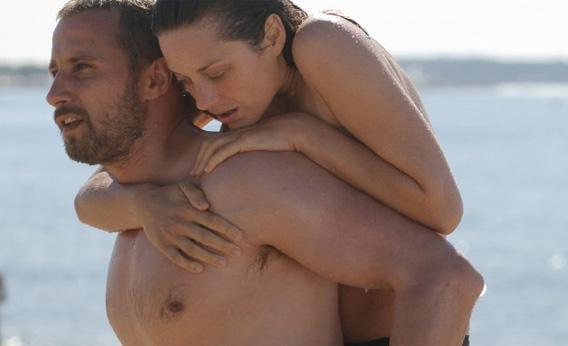Rust and Bone (Sony Classics), a gritty, transporting romance from the French director and writer who brought us the shattering 2009 prison drama A Prophet (Jacques Audiard and Thomas Bidegain), performs a curious act of alchemy on what sounds on paper like the hokiest premise ever: A down-on-his-luck amateur kickboxer falls in love with a beautiful killer-whale trainer who’s lost both her legs in an accident during a live show at a Sea World-like place called Marineland. Cue the uplifting surge of triumph-over-disability music, right? Except not at all, because Rust and Bone (based loosely on a short story collection by the Canadian writer Craig Davidson) turns out to be a film that’s as compact and modest as it is urgent and passionate.
Rust and Bone triumphs over its own potential hokeyness in no small part because of the frank physical chemistry between its two hugely charismatic stars, Matthias Schoenaerts (the hulking-yet-gentle Belgian actor who starred in last year’s Bullhead) and Marion Cotillard. Cotillard has had a run of more or less conventional supporting roles in Hollywood since her Oscar-winning turn as Edith Piaf in La Vie en Rose. She played the love-interest-turned-villain in The Dark Knight Rises, Leonardo Di Caprio’s elusive wife in Inception, and Owen Wilson’s transhistorical muse in Midnight in Paris. Rust and Bone comes as a welcome reminder that, extraterrestrially gorgeous though Cotillard is, she shouldn’t be limited to playing polished, serene objects of male desire. Her character here, Stéphanie, is a viscerally sexual, fiercely independent woman, an orca trainer by day and party girl by night who crosses paths with Schoenaerts’ nightclub bouncer, Ali, after she gets in a drunken fight at his club and has to be driven home.
Ali is on the run with his 5-year-old son Sam (Armand Verdure) after the boy’s mother attempted to use him as a mule in a drug-smuggling operation. Father and son arrive in Antibes at the house of Ali’s sister (Corinne Masiero), an employee at a big-box store who reluctantly agrees to take the pair in despite her brother’s poor impulse control and on-again, off-again parenting skills—obsessed with kickboxing and mixed martial arts, he would rather watch training videos online than keep an eye on his lonely, needy son.
After Stéphanie loses both legs above the knee (in an accident that’s shown, artfully and without excessive gore, from an underwater whale’s-eye POV), she enters a period of deep depression, in the midst of which—for reasons that are never quite made clear—she decides to call up the Belgian bouncer who drove her home that night. Slowly the two of them initiate a friendship that’s at first physical without being sexual—on their initial outing together, Ali takes her to the beach, where his animal enjoyment of the water encourages her to join him for a swim, recently healed stumps be damned.
Whatever digital trickery is used to strip Cotillard of her legs, it’s so beautifully and simply done that we soon stop thinking of her amputee status as a special effect and accept it as a simple physical truth. When things do get sexual between Ali and Stéphanie (after a matter-of-fact lunch conversation in which he offers to help her discover “if it still works”), their love scenes together are frequent, naked, graphic, and sizzling hot. It’s easy to believe that these two very different people—an educated animal trainer and a barely verbal meathead—share a powerful connection at the level of their bodies, a bond that they need more than they understand it. The most effective moments in Rust and Bone have to do with the joys and perils of possessing a body: Late in the film, when Ali takes up fighting for money in an illegal kickboxing ring, Stéphanie watches from the sidelines with a mixture of fear, excitement, and sexual desire.
Not every viewer will be seduced by Rust and Bone’s style, which might be classified as romantic naturalism. There’s plenty of roving, intimate handheld camera in the style of the Dardenne brothers (whose company helped produce the film), but the movie’s tone couldn’t be farther from Dardennes’ emotional austerity. Audiard is partial to long poetic montages of light on water, copious lens flares, and the pull-out-the-stops manipulative power of American pop music. A short scene of Stéphanie rocking out alone in her wheelchair to the sound of the B-52s’ “Love Shack” tells us everything we need to know about the mojo she’s slowly recovering. And a later scene, in which Stéphanie returns alone to Marineland to re-encounter the orcas who deprived her of her legs, must surely represent the most exhilarating narrative use to which Katy Perry’s “Firework” has ever been put.
Looking back at Rust and Bone afterward, you may feel surprise, even shame, that you managed to care so much about this none-too-original story of two damaged people whose unexpected connection helps them each find their way out of a bad place in their lives. But Rust and Bone is a movie about letting go of shame and making way for the advent of pleasure. Let that be your guide to watching it as well.
